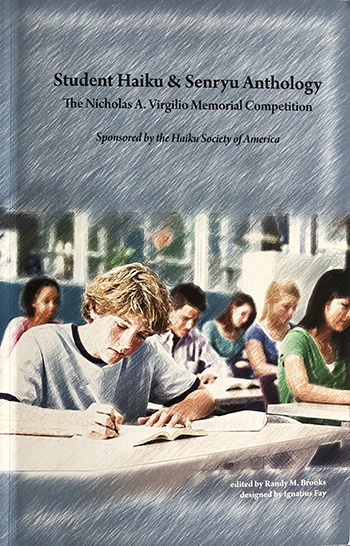Haiku Society of America Student Haiku Awards
in Memorial of Nicholas A. Virgilio
~ ~ ~
Student Haiku Awards for 2010
Janelle Barrera and Fran Masat
judges
Presented with 1,575 student haiku, we decided to read all on our own and then compare notes. In our top twenty picks, we each chose two of the same haiku. That was a real start! From there, our next top 20 produced the remaining four winners. While there is no particular order in the list of winners, the first two listed are the first two haiku we chose.
The students wrote about insightful moments related to nature, friends, family, and pets. Human nature took precedence over nature, per se, yet it is always there setting the scene. These are our top six choices, but there were many more in close contention. Thanks to each of the young authors. ~ Janelle Barrera and Fran Masat
autumn rain
rinsing the color
from the leavesLauren Winters
Hilliard Davidson High School, Age 18, Grade 12, Hilliard, OHThat a storm has downed leaves is not unusual. But here, in a refreshing manner, the author notes the more sensitive loss, that of color. More broadly, the haiku illustrates the notion of age diminishing the quality of life and that resonates with all of us.
cold night
the phone call . . .
from a disowned sisterHanna Amireh
School of the Arts, Age 17, Grade 12, Rochester, NYWe’ve all waited for a phone call. As cold night sets the tone and scene, the pivotal second line provides an almost proverbial structure: “the phone call from . . .” That the call is from a disowned sister sheds light on an almost universal vulnerability—on both ends of the phone. What happens next will reveal much about ourselves and how we relate to such events.
on the windowsill
next to the box of ashes
Jiro’s dog collarMichelle Hosoda
Sage Hill School, Age 17, Grade 12, Newport Coast, CAA first impression may be that of a memorial to companionship, but there is more. The ashes are not identified, though “next to” does hint at the link between them and Jiro. Instead, it is the empty circle of the collar that evokes a desire to look beyond the sill and glimpse what that linkage may represent.
rural Peru
5 lollypops
for a handmade braceletCaitlin Sullivan
Sage Hill School, Age 18, Grade 12, Newport Coast, CA“5 lollypops” seems out of place in rural Peru until we re-think the trade proposed. The contrasts of machined candy to rural handicraft and of dissolving sweetness to tangible artifact provide deeper insight into the nature of the scene. By comparing the differing wants of two cultures, the haiku thus provides a resonant view of our global society.
Grandad’s funeral
she wonders
whether she looks fatAlice Liu
Sage Hill School, Age 14, Grade 9, Newport Coast, CAAt most gatherings, there always seems to be someone who, obviously, is wondering about themselves. Maybe the thought is real, or perhaps it’s unconscious self-protection from the truths of the gathering, in this case death. We are held until the last word before we are given a clue as to which. Even then, it is our interpretation—but isn’t it always?
under the shade
of sunflowers,
my mouse decaysLaura Hansen
Capital High School, Age 18, Grade 12, Boise, IDSo many things can happen in the shade of sunflowers. Here, in a straightforward and void of melancholy manner, it is the slow sureness of decay that illuminates that shade. In a broader and almost celebratory sense, life rises above death.
~ ~ ~
About our 2010 judges:
Janelle Barrera is a former teacher and now tutors foreign language students in Key West. She enjoys writing haiku with school children and has published haiku, haibun and poetry. She and Francis Masat are co-editors of the “Key Ku” column in Solares Hill, a weekly Sunday magazine, and she was implemental in introducing haiku workshops to the annual Robert Frost Poetry Festival in Key West. “Reading the students’ haiku was a genuine pleasure,” she says.
Francis Masat lives in Key West, FL. With over 1000 poems and haiku in over 100 journals, his recent chapbooks are Lilacs After Winter (haibun), MET Press, A Taste of Key West, Pudding House Press, and Threshing, March Street Press.
